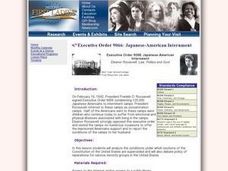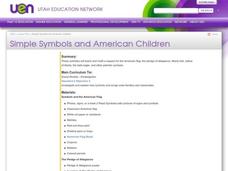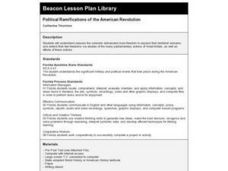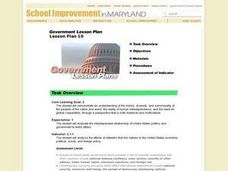Curated OER
Kill the Indian to Save the Man: Reservations, Assimilation, and Native American Resistance and Persistence in the West
High schoolers investigate the theory versus the reality of US government reservation policy in the mid to late 19th Century by watching a video. They design a time line that shows how the individual tribes surrendered to the reservation...
Curated OER
The Role of American Embassies
Students examine services provided by US embassies abroad. They determine what US ambassadors and embassies do in relation to US foreign policy and the protection of American interests.
Curated OER
An Irresistable Offer?
Young scholars identify inducements the emperor Constantine offered people to move to his fledgling capital city of Constantinople and compare similar situations offered by the American government in our history and by local governments...
National First Ladies' Library
Executive Order 9066: Japanese-American Internment
Students analyze conditions under which sections of United States Constitution are superceded, research history of Native Americans, African Americans, and Japanese Americans, and debate policy of reparations for various minority groups...
Curated OER
The Alien and Sedition Acts: Defining American Freedom
Eleventh graders explore the purpose of the Alien and Sedition Acts. For this US History lesson, 11th graders analyze primary source documents. Students write an essay using writing prompts.
Curated OER
What is American Culture
Students create what they feel is American Culture using a video camera and capturing 5 frames. They are animating parts of a poem in small groups. They decide the set up, create movable figures, and have a music section. Each person...
Curated OER
The Story Of American Freedom
Students investigate the concept of American freedom with the use of primary sources of images in order to derive meaning. The images are used to inspire research and writing about historical scenes. The writing and analysis of the...
Curated OER
Simple Symbols and American Children
Students are introduced to a variety of symbols representing the United States. As a class, they identify places in which they have seen the various symbols and discuss what they mean. To end the lesson, they state the words from the...
Curated OER
The Cuban Missile Crisis: A Lesson in Decision Making
In this American History worksheet, 11th graders analyze different scenarios and create possible solutions.
Curated OER
Philanthropy in History Lesson 1: We the People Hall of Fame
Students examine the lives of people who contributed to the common good, and democracy. They investigate grievances that lead to the call for American independence and look at the costs that are incurred as a result of personal acts of...
Curated OER
Government Lesson Plan: Lesson Plan 6
Students examine legislation on immigration policies. They discuss current immigration laws, read a handout, complete a chart, and answer discussion questions.
Curated OER
Defining Moments From the Past: Japanese American Internment
Students conduct a mock Congressional Hearing to decide whether or not Japanese Americans who were sent to internment camps during World War II should be provided financial restitution. They research and create a time line of events...
Curated OER
Political Ramifications of the American Revolution
Students, in groups, research a topic from the Revolutionary War. They present their research to the class as a review and the instructor summarizes important information. They take a test on the presented topics.
Curated OER
Government Lesson Plan 18
Learners identify problems with a pure market economy, and examine and explain roles of selected regulatory agencies.
Curated OER
The Institutions of Government: The Judiciary
Students explain the difference between tribal, state and federal sovereignty. Using the internet, they read Supreme Court cases that focus on Native American law. They compare and contrast the view of the case from the Native...
Curated OER
Government Lesson Plan: Lesson Plan 10
High schoolers explore the history, diversity, and commonality of the peoples of the nation and world. They analyze how the United States' political, economic and social goals directly affect our foreign policy.
Curated OER
Local Government Internet Project
Eighth graders use given websites to gather information needed to complete a worksheet regarding county, city, and school governmental districts. They write and create presentation on their county to share with class.
Museum of Tolerance
The Role of Citizens in a Participatory Democracy
Groups research participatory democracies and compare the role and rights of citizens in ancient history with those in recent U.S. history. Guided by a series of questions, individuals compose a persuasive essay in which they discuss the...
Alabama Department of Archives and History
Alabama's 1901 Constitution
"We, the People of the State of Alabama. . ." Did you know that the Alabama State Constitution has 357,157 words while the US Constitution has only 4,400? And that it has 798 amendments while the US Constitution has...
Curated OER
The Happy Progress of Our Affairs: George Washington and the U.S. Constitution
Students engage in a lesson which uses Washington's own words to illustrate the events leading to the establishment of our national government, and the crucial roles he played throughout that process.
Curated OER
"In God We Trust": The Camden Man Who Put the Missing Motto on the Dollar Bill
Here is a fascintating lesson plan which relates how the motto "In God We Trust" came to appear on all US currency. It turns out that a man from Arkansas came up with the idea and petioned his congressman and President Eisenhower himself...
James Madison Memorial Fellowship Foundation
A Picture is Worth a Thousand Words
This exercise on the Constitution requires small groups to design a visual metaphor that expresses the concept behind one of seven principles: popular sovereignty, federalism, republicanism, separation of powers, checks and balances,...
Curated OER
The Federalist Defense of Diversity: Extending the Sphere
How did early Americans ensure expansion while also securing the rights of citizens? Alexander Hamilton and James Madison, two of our early leaders, considered the problem of faction to be the "mortal disease" that created unstable...
Curated OER
Integrity and Firmness is All I Can Promise: The Washington Presidency
Students engage in a lesson which addresses George Washington's leadership as President of the United States. They review a variety of letters written by Washington online, and prepare reports for the class.























